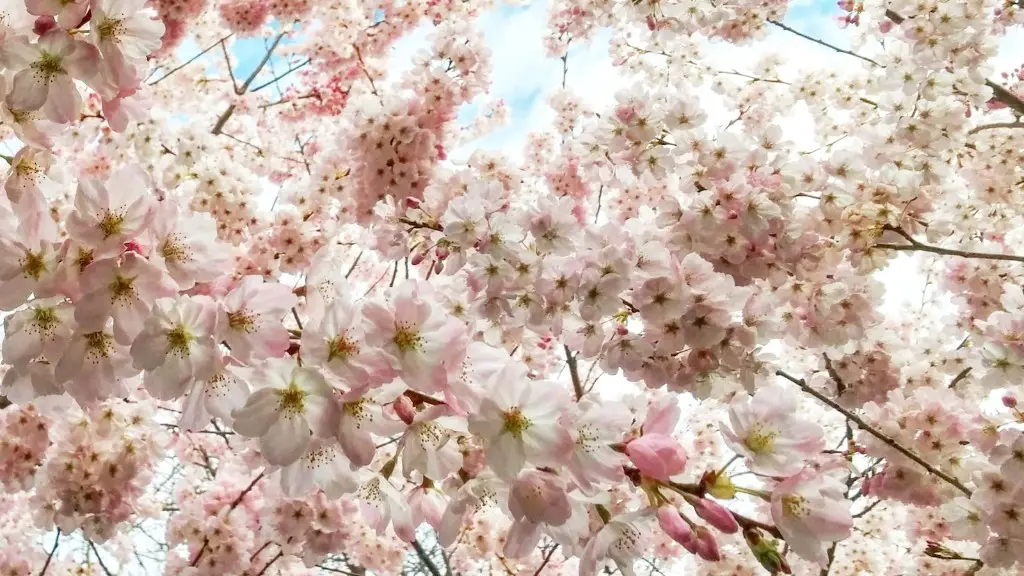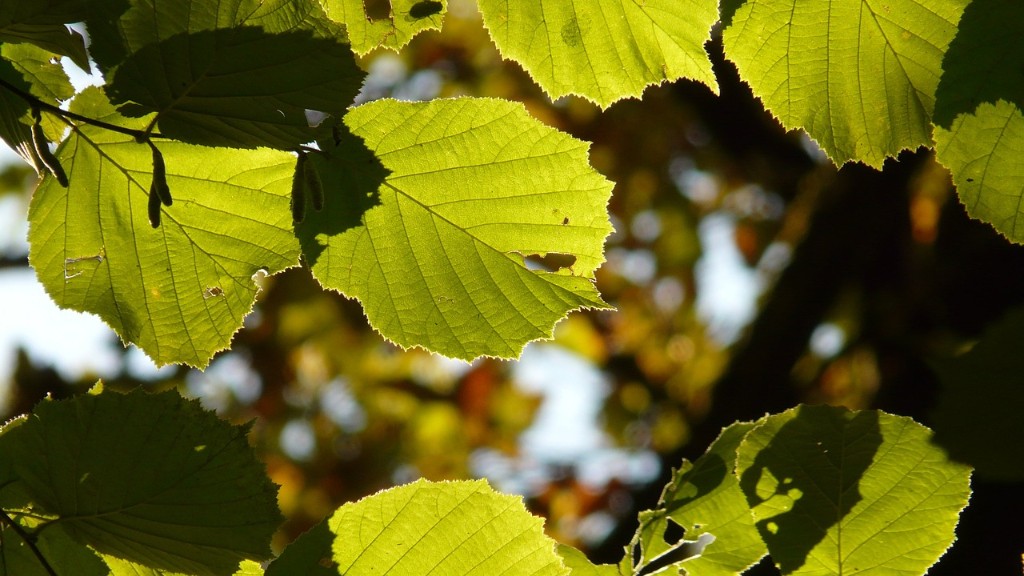Lack of Nutrients in Soil
The most common reason why cherry tree leaves are turning yellow is due to a lack of nutrients in the soil. This occurs when the soil doesn’t contain enough essential minerals such as nitrogen, sulfur, phosphorous and potassium, which are needed for the tree’s healthy growth and development. When these nutrients are not available, the leaves can become yellow and fall off prematurely.
In order to determine if your tree’s yellowing leaves are the result of a nutrient deficiency, it is essential to test the soil. A professional soil analysis is the best way to ensure that your soil is containing the right nutrients in the right proportions. If a deficiency is then confirmed, there are a few ways in which you can boost your soil’s nutrients.
Adding organic compost to the soil is an economical and easy-to-implement solution. Compost is full of beneficial nutrients that help increase a tree’s growth and vigor. It also helps to improve the soil structure and drainage, further boosting the plant’s health. Other organic materials such as manure, grass clippings, shredded leaves, and peat moss can also be added to the soil for a greater nutrient boost.
The best way to increase a tree’s health is to grow them in soil with adequate nutrients. If this isn’t possible, applying a balanced fertilizer is the next best option. Fertilizers like 10-10-10, working as a slow-release or liquid fertilizers, are an excellent option. When applying fertilizers, it is important to follow the instructions on the package and never apply more than is recommended.
Disease Considerations
While nutrient deficiencies are the most common cause of yellowing leaves in cherry trees, it is important to consider potential diseases or pests that may be causing the issue. For instance, verticillium wilt is a fungal disease that can cause yellowing leaves and eventual tree death if left untreated. Similarly, caterpillars and aphids can strip cherry trees of their leaves, leading to yellowing and, if persistent, tree death.
Fortunately, there are a few things you can do to maintain the health of your tree and better guard against these issues. Start by keeping your tree pruned and well-watered. This helps to aerate the tree, allowing for improved performance, and it gives it the moisture it needs to stay healthy and vibrant. Pruning should always be done carefully and with a professional arborist if necessary, as the wrong pruning technique can lead to a greater number of ailments.
In addition to keeping your tree pruned and well-watered, another way to prevent diseases and pests is to ensure that your tree is planted in the right location and soil. Cherry trees prefer well-drained, slightly acidic soils with organic matter, and they should be located in a spot that gets plenty of sun and is protected from wind.
Environmental Factors
Environmental cues can also cause a cherry tree to display yellowing leaves and other signs of distress. For instance, sudden changes in temperature can cause a tree to react negatively and may cause leaves to yellow and fall off. To help minimize these effects, make sure to provide consistent care and maintenance to your tree throughout the seasons.
Limiting the amount of water your tree receives can also help to prevent yellowing leaves. Over-watering can result in nutrient deficiencies, as the excess of water can leach essential nutrients from the soil. Too much water can also lead to waterlogged soil, preventing oxygen and essential nutrients from penetrating the roots of your tree.
Finally, it is important to limit or avoid the use of chemical fertilizers or pesticides in and around your tree. These products can cause root and leaf damage, leading to yellowing leaves. If any chemical products must be used, always make sure to read the instructions on the product and follow them closely.
Average Honeydew Level in Trees
An issue you may experience with your cherry tree is a buildup of honeydew, which is a sticky substance produced by aphids and other pests. This honeydew can coat your tree’s leaves and branches and attract other pests and diseases. If left untreated it can lead to yellowing, browning, and premature leaf fall.
In order to reduce honeydew, regular monitoring of your tree is essential. Check the leaves and branches of the tree for signs of pests and the presence of honeydew. If either of these are present, consider pruning or cutting away any infected parts and use a biopesticide or insecticidal soap to control the pests. If necessary, contact a professional to assess the situation.
Sunscald and Injury to Leaves
Though not as common as nutrient deficiency or pests, it is still important to consider other factors when assessing why your tree leaves are turning yellow. Sunscald, or sunburn, can occur if your tree is exposed to too much direct sunlight. This can cause browning, yellowing, and premature leaf fall. To limit this issue, consider planting your tree in a partially shaded location and protect it from wind with a windbreak.
Injury to leaves is also a potential cause of yellowing. If your tree is physically damaged by other plants, animals, or mechanical equipment, it can result in leaves turning yellow and eventually falling off. If you notice any kind of physical damage to your tree, contact a professional arborist right away.
Detecting Early Symptoms of Stress
Early symptoms of stress in your cherry tree can be difficult to detect, but there are a few things to look for. Symptoms can appear as yellowing leaves, a lack of new growth, weak leaves, and premature leaf drop. If you notice any of these, it is important to investigate the cause and take proactive measures to protect your tree from further damage.
Improper watering, nutrient deficiencies, pests, disease, sunscald, environmental cues, and physical damage are all factors that can result in yellowing leaves in cherry trees. When assessing the issue, it is important to consider all potential factors, ensure your soil is receiving the right nutrients, and to keep a close eye on the health of your tree.
Seasons and Temperature
The season can also play a role in the health of your cherry tree. While most cherry trees will remain healthy throughout winter and summer, extreme temperatures can cause distress. During winter, temperatures can cause yellowing, frosts can damage leaves, and wind chill can cause stunted growth. In summer, extreme heat or drought can cause leaves to yellow prematurely and lead to decreased growth.
When caring for your cherry tree, always make sure to set irrigation systems and other maintenance tasks according to the season. this will better protect your tree from the distress caused by extreme temperatures. In addition, avoid pruning your tree during extreme weather and, if necessary, move it to a more protected location to give it extra protection.
Signs of Improvement
When implementing the solutions above, it is important to monitor your tree’s progress and look for signs of improvement in the health of the leaves. Start by assessing the leaves for signs of pests or pathogens, and check the general health of the leaves. If signs of yellowing have improved, you have likely found the solution and can begin taking the necessary steps to maintain the health of your tree.
Fungal Disease Infections
Fungal diseases can be a serious problem for cherry trees, as they can cause severe yellowing and premature leaf drop. Many types of fungi can be the culprit and, if left untreated, can cause irreparable damage to the tree. In order to preempt or treat any fungal issues, it is important to monitor the health of the tree regularly and take the necessary precautions to protect it.
If you suspect a fungal issue, it is important to contact an arborist and have the tree assessed. The arborist may suggest treatments such as lime sulfur or other types of fungicides in order to combat the fungus. Make sure to always use the product as directed to get the most effective treatment.
Improve Tree Vigor
The health of an individual tree plays a significant role in its overall vigor and growth. To keep the tree healthy, monitor it regularly and look for the early signs of disease or pests. Make sure to invest in the right soil and fertilizer, give it the proper irrigation and nutrition, and prune and care for it as necessary.
The best way to ensure a healthy cherry tree is to give it the right care and attention. This means providing the right soil, nutrition, and protection against pests, disease, and environmental issues. If done right, you can expect a vigorous tree that is likely to withstand the test of time.
Stay Vigilant
It is important to stay vigilant when caring for cherry trees. Regular monitoring of the tree’s condition and speaking with a professional arborist can help ensure that any potential issues are addressed before they get too severe. Doing so can also help reduce the need for costly treatments and help to minimize stress on the tree.
Finally, it is important to understand the signs of stress and health in your tree. Early detection of signs such as yellowing leaves, pests, disease, and environmental issues can often save you from costly treatments and significantly reduce the stress on your tree.


